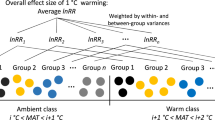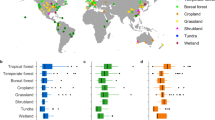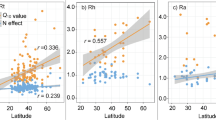Abstract
The impact of more extreme climate conditions under global warming on soil organic carbon (SOC) dynamics remains unquantified. Here we estimate the response of SOC to climate extreme shifts under 1.5 °C warming by combining a space-for-time substitution approach and global SOC measurements (0–30 cm soil). Most extremes (22 out of 33 assessed extreme types) exacerbate SOC loss under warming globally, but their effects vary among ecosystems. Only decreasing duration of cold spells exerts consistent positive effects, and increasing extreme wet days exerts negative effects in all ecosystems. Temperate grasslands and croplands negatively respond to most extremes, while positive responses are dominant in temperate and boreal forests and deserts. In tundra, 21 extremes show neutral effects, but 11 extremes show negative effects with stronger magnitude than in other ecosystems. Our results reveal distinct, biome-specific effects of climate extremes on SOC dynamics, promoting more reliable SOC projection under climate change.
This is a preview of subscription content, access via your institution
Access options
Access Nature and 54 other Nature Portfolio journals
Get Nature+, our best-value online-access subscription
$29.99 / 30 days
cancel any time
Subscribe to this journal
Receive 12 print issues and online access
$209.00 per year
only $17.42 per issue
Buy this article
- Purchase on Springer Link
- Instant access to full article PDF
Prices may be subject to local taxes which are calculated during checkout





Similar content being viewed by others
Data availability
The 33 climate extreme indices can be accessed at https://doi.org/10.1594/PANGAEA.898014. Global mapping products generated in this study are publicly available and deposited to https://doi.org/10.6084/m9.figshare.22317202. Other data used in this study are the same to those used in ref. 21, which are publicly accessible. The coastline data in all maps can be gained from https://www.naturalearthdata.com/downloads/50m-physical-vectors/50m-coastline/.
Code availability
Code (R scripts)68 used to assess the data and generate the results is deposited at https://doi.org/10.6084/m9.figshare.22317202.
References
Seneviratne., S. I. et al. in Managing the Risks of Extreme Events and Disasters to Advance Climate Change Adaptation (eds Field, C. B. et al.) 109–230 (Cambridge Univ. Press, 2012).
Reichstein, M. et al. Climate extremes and the carbon cycle. Nature 500, 287–295 (2013).
Frank, D. et al. Effects of climate extremes on the terrestrial carbon cycle: concepts, processes and potential future impacts. Glob. Change Biol. 21, 2861–2880 (2015).
Gampe, D. et al. Increasing impact of warm droughts on northern ecosystem productivity over recent decades. Nat. Clim. Change 11, 772–779 (2021).
Ciais, P. et al. Europe-wide reduction in primary productivity caused by the heat and drought in 2003. Nature 437, 529–533 (2005).
Zscheischler, J., Mahecha, M. D., Harmeling, S. & Reichstein, M. Detection and attribution of large spatiotemporal extreme events in Earth observation data. Ecol. Inf. 15, 66–73 (2013).
Sippel, S. et al. Drought, heat, and the carbon cycle: a review. Curr. Clim. Change Rep. 4, 266–286 (2018).
Friedlingstein, P. et al. Global carbon budget 2021. Earth Syst. Sci. Data 14, 1917–2005 (2022).
Crowther, T. W. et al. Quantifying global soil carbon losses in response to warming. Nature 540, 104–108 (2016).
Xiao, L. et al. Younger carbon dominates global soil carbon efflux. Glob. Change Biol. 28, 5587–5599 (2022).
Smith, M. D., Knapp, A. K. & Collins, S. L. A framework for assessing ecosystem dynamics in response to chronic resource alterations induced by global change. Ecology 90, 3279–3289 (2009).
Sippel, S., Zscheischler, J. & Reichstein, M. Ecosystem impacts of climate extremes crucially depend on the timing. Proc. Natl Acad. Sci. USA 113, 5768–5770 (2016).
Lugato, E. et al. Soil erosion is unlikely to drive a future carbon sink in Europe. Sci. Adv. 4, eaau3523 (2018).
Van Oost, K. et al. The impact of agricultural soil erosion on the global carbon cycle. Science 318, 626–629 (2007).
Anderegg, W. R. et al. Pervasive drought legacies in forest ecosystems and their implications for carbon cycle models. Science 349, 528–532 (2015).
Anjileli, H. et al. Extreme heat events heighten soil respiration. Sci. Rep. 11, 6632 (2021).
Bardgett, R. D. & Caruso, T. Soil microbial community responses to climate extremes: resistance, resilience and transitions to alternative states. Philos. Trans. R. Soc. Lond. B 375, 20190112 (2020).
Deng, L. et al. Drought effects on soil carbon and nitrogen dynamics in global natural ecosystems. Earth Sci. Rev. 214, 103501 (2021).
Diffenbaugh, N. S. et al. Quantifying the influence of global warming on unprecedented extreme climate events. Proc. Natl Acad. Sci. USA 114, 4881–4886 (2017).
Fischer, E. M., Sippel, S. & Knutti, R. Increasing probability of record-shattering climate extremes. Nat. Clim. Change 11, 689–695 (2021).
Wang, M. et al. Global soil profiles indicate depth-dependent soil carbon losses under a warmer climate. Nat. Commun. 13, 5514 (2022).
Karl, T. R., Nicholls, N. & Ghazi, A. in Weather and Climate Extremes: Changes, Variations and a Perspective from the Insurance Industry (eds Karl, T. R. et al.) 3–7 (Springer Netherlands, 1999).
Mistry, M. A high-resolution global gridded historical dataset of climate extreme indices. Data 4, 41 (2019).
Karl, T. R., Nicholls, N. & Ghazi, A. Clivar/GCOS/WMO workshop on indices and indicators for climate extremes workshop summary. Weather Clim. Extremes 42, 3–7 (1999).
Kim, Y.-H., Min, S.-K., Zhang, X., Sillmann, J. & Sandstad, M. Evaluation of the CMIP6 multi-model ensemble for climate extreme indices. Weather. Clim. Extremes 29, 100269 (2020).
Zscheischler, J. et al. Future climate risk from compound events. Nat. Clim. Change 8, 469–477 (2018).
Bardgett, R. D. & Caruso, T. Soil microbial community responses to climate extremes: resistance, resilience and transitions to alternative states. Philos. Trans. R. Soc. B 375, 20190112 (2020).
Bennett, A. C. et al. Resistance of African tropical forests to an extreme climate anomaly. Proc. Natl Acad. Sci. USA 118, e2003169118 (2021).
Zhao, M. & Running, S. W. Drought-induced reduction in global terrestrial net primary production from 2000 through 2009. Science 329, 940–943 (2010).
Tao, F. et al. Microbial carbon use efficiency promotes global soil carbon storage. Nature 618, 981–985 (2023).
Eckardt, N. A. et al. Climate change challenges, plant science solutions. Plant Cell 35, 24–66 (2023).
Xue, K. et al. Tundra soil carbon is vulnerable to rapid microbial decomposition under climate warming. Nat. Clim. Change 6, 595–600 (2016).
Plaza, C. et al. Direct observation of permafrost degradation and rapid soil carbon loss in tundra. Nat. Geosci. 12, 627–631 (2019).
Liu, Q. et al. Drought-induced increase in tree mortality and corresponding decrease in the carbon sink capacity of Canada’s boreal forests from 1970 to 2020. Glob. Change Biol. 29, 2274–2285 (2023).
Slessarev, E. W. et al. Initial soil organic carbon stocks govern changes in soil carbon: reality or artifact? Glob. Change Biol. 29, 1239–1247 (2023).
Cotrufo, M. F., Ranalli, M. G., Haddix, M. L., Six, J. & Lugato, E. Soil carbon storage informed by particulate and mineral-associated organic matter. Nat. Geosci. 12, 989–994 (2019).
Lugato, E., Lavallee, J. M., Haddix, M. L., Panagos, P. & Cotrufo, M. F. Different climate sensitivity of particulate and mineral-associated soil organic matter. Nat. Geosci. 14, 295–300 (2021).
Du, E. et al. Global patterns of terrestrial nitrogen and phosphorus limitation. Nat. Geosci. 13, 221–226 (2020).
Wang, H., Richardson, C. J. & Ho, M. Dual controls on carbon loss during drought in peatlands. Nat. Clim. Change 5, 584–587 (2015).
Bao, T., Jia, G. & Xu, X. Weakening greenhouse gas sink of pristine wetlands under warming. Nat. Clim. Change 13, 462–469 (2023).
Gauthier, S., Bernier, P., Kuuluvainen, T., Shvidenko, A. Z. & Schepaschenko, D. G. Boreal forest health and global change. Science 349, 819–822 (2015).
Wang, J., Taylor, A. R. & D’Orangeville, L. Warming-induced tree growth may help offset increasing disturbance across the Canadian boreal forest. Proc. Natl Acad. Sci. USA 120, e2212780120 (2023).
Jarvis, P. & Linder, S. Constraints to growth of boreal forests. Nature 405, 904–905 (2000).
Lim, H. et al. Boreal forest biomass accumulation is not increased by two decades of soil warming. Nat. Clim. Change 9, 49–52 (2018).
Wang, P., Huang, K. & Hu, S. Distinct fine-root responses to precipitation changes in herbaceous and woody plants: a meta-analysis. New Phytol. 225, 1491–1499 (2020).
Vereecken, H. et al. Soil hydrology in the Earth system. Nat. Rev. Earth Environ. 3, 573–587 (2022).
García-Palacios, P. et al. Evidence for large microbial-mediated losses of soil carbon under anthropogenic warming. Nat. Rev. Earth Environ. 2, 507–517 (2021).
Ridder, N. N. et al. Global hotspots for the occurrence of compound events. Nat. Commun. 11, 5956 (2020).
Xu, L., Wang, A., Wang, D. & Wang, H. Hot spots of climate extremes in the future. J. Geophys Res. Atmos. 124, 3035–3049 (2019).
Tschumi, E. & Zscheischler, J. Countrywide climate features during recorded climate-related disasters. Climatic Change 158, 593–609 (2020).
Batjes, N. H., Ribeiro, E. & van Oostrum, A. Standardised soil profile data to support global mapping and modelling (WoSIS snapshot 2019). Earth Syst. Sci. Data 12, 299–320 (2020).
Mishra, U. et al. Spatial heterogeneity and environmental predictors of permafrost region soil organic carbon stocks. Sci. Adv. 7, eaaz5236 (2021).
Fick, S. E. & Hijmans, R. J. WorldClim 2: new 1-km spatial resolution climate surfaces for global land areas. Int. J. Climatol. 37, 4302–4315 (2017).
Olson, D. M. et al. Terrestrial ecoregions of the world: a new map of life on Earth: a new global map of terrestrial ecoregions provides an innovative tool for conserving biodiversity. Bioscience 51, 933–938 (2001).
Channan, S., Collins, K. & Emanuel, W. Global Mosaics of the Standard MODIS Land Cover Type Data (Univ. of Maryland & Pacific Northwest National Laboratory, 2014).
Meybeck, M., Green, P. & Vörösmarty, C. A new typology for mountains and other relief classes: an application to global continental water resources and population distribution. Mt. Res. Dev. 21, 34–45 (2001).
Alexander, L. V. Global observed long-term changes in temperature and precipitation extremes: a review of progress and limitations in IPCC assessments and beyond. Weather Clim. Extremes 11, 4–16 (2016).
Rodell, M. et al. The global land data assimilation system. Bull. Am. Meteorol. Soc. 85, 381–394 (2004).
Alexander, L. V. & Perkins, S. E. On the measurement of heat waves. J. Clim. 26, 4500–4517 (2013).
Sheridan, S. C. & Lee, C. C. Temporal trends in absolute and relative extreme temperature events across North America. J Geophys. Res. Atmos. 123, 11889–11898 (2018).
Vicente-Serrano, S. M., Beguería, S. & López-Moreno, J. I. A multiscalar drought index sensitive to global warming: the standardized precipitation evapotranspiration index. J. Clim. 23, 1696–1718 (2010).
Schwalm, C. R. et al. Global patterns of drought recovery. Nature 548, 202–205 (2017).
Chen, H., Wang, S., Zhu, J. & Zhang, B. Projected changes in abrupt shifts between dry and wet extremes over China through an ensemble of regional climate model simulations. J. Geophys. Res. Atmos. 125, e2020JD033894 (2020).
IPCC Special Report on Global Warming of 1.5 °C (eds Masson-Delmotte, V. et al.) (WMO, 2018).
Bevacqua, E., Zappa, G., Lehner, F. & Zscheischler, J. Precipitation trends determine future occurrences of compound hot–dry events. Nat. Clim. Change 12, 350–355 (2022).
Strayer, D. et al. Long-term ecological studies: an illustrated account of their design, operation, and importance to ecology. Occasional Publ. Inst. Ecosyst. Stud. 2, 1–38 (1986).
FAO, IIASA, ISRIC, ISS-CAS & JRC Harmonized World Soil Database version 1.2 (FAO & IIASA, 2012).
Wang, M. & Luo, Z. Changes in soil organic carbon in response to climate extremes under warming across globe biomes. figshare https://doi.org/10.6084/m9.figshare.22317202.v1 (2023).
Acknowledgements
This research has been financially supported by the National Natural Science Foundation of China (grant number 32241036, 32171639) and the National Key Research Program of the Ministry of Science and Technology of China (grant number 2021YFE0114500). Contributions of U.M. were supported through a US Department of Energy grant to the Sandia National Laboratories, which is a multi-mission laboratory managed and operated by National Technology and Engineering Solutions of Sandia LLC, a wholly owned subsidiary of Honeywell International Inc. for the US Department of Energy’s National Nuclear Security Administration under contract DE-NA-0003525.
Author information
Authors and Affiliations
Contributions
Z.L. conceived the study; M.W. and Z.L. led data assessment; Y.Y. and U.M. contributed to permafrost data; Z.L. and M.W. interpreted the results with the contribution of all authors; Z.L. and M.W. led the writing of the manuscript and all authors improved the manuscript.
Corresponding author
Ethics declarations
Competing interests
The authors declare no competing interests.
Peer review
Peer review information
Nature Climate Change thanks Emanuele Lugato and the other, anonymous, reviewer(s) for their contribution to the peer review of this work.
Additional information
Publisher’s note Springer Nature remains neutral with regard to jurisdictional claims in published maps and institutional affiliations.
Extended data
Extended Data Fig. 2 The additional changes in soil organic carbon induced by climate extremes under a warmer and more extreme climate.
The dependence of additional changes in soil organic carbon (ΔSOCE) on the change levels of climate extremes under a warmer and more extreme climate. Grey grids indicate that the estimated dependence is statistically insignificant (P > 0.05). TS forests, tropical/subtropical forests; Med/Mon shrublands, Mediterranean/montane shrublands; TS grasslands/savannas, tropical/subtropical grasslands/savannas. Detailed descriptions of CEIs are shown in Supplementary Table 1.
Extended Data Fig. 3 The comparison of soil organic carbon changes induced by changes in extreme dry magnitude using our approach with file drought experimental results.
Comparison of soil organic carbon changes induced by changes in extreme dry magnitude (EDM). Deng et al. (2021) synthesized the data from field experiments. Biomes are grouped into tundra, shrublands, grasslands, and forests. Dots with bars show the mean effect sizes with 95% confidence intervals, and numbers besides them are sample sizes used to calculate the mean effect size. The actual drought levels (that is, the reduction of precipitation) in field drought experiments were normalized to annual mean precipitation. The change level in our estimation which is close most to the experimental change level was targeted to conduct the comparison.
Extended Data Fig. 4 The performance of random forest model.
The performance of random forest model on predicting soil organic carbon responses attributed to eight climate extremes under a warmer and more extreme climate. Detailed descriptions of climate extreme indices (CEIs) are shown in Supplementary Table 1.
Extended Data Fig. 5 The distribution of global wetlands and the location of soils with organic carbon stock of >300 Mg C ha–1 (0–30 cm) used in this study.
The wetland map data is obtained from http://www.wwfus.org/science/data.cfm.
Extended Data Fig. 6 The partial depended relationship of soil organic carbon changes with background climate extreme conditions.
The relationship of soil organic carbon changes (that is, ΔSOCE) with background climate extreme conditions. Partial dependence of ΔSOCE induced by a typical CEI on corresponding background CEI. Detailed descriptions of the eight CEIs are shown in Supplementary Table 1.
Extended Data Fig. 7 The global spatial pattern of absolute changes in soil organic carbon stock under a warmer and more extreme climate.
Global spatial pattern of absolute changes in soil organic carbon stock attributed to climate extreme shifts under a warmer and more extreme climate. a-h, eight climate extremes including heat wave magnitude (a) and frequency (b), cold wave magnitude (c) and frequency (d), extreme dry magnitude (e) and frequency (f), extreme wet magnitude (g) and frequency (h).
Extended Data Fig. 8 The uncertainty of soil organic carbon relative changes under a warmer and more extreme climate.
Uncertainty of soil organic carbon changes attributed to climate extreme shifts (ΔSOCE) under a warmer and more extreme climate. ΔSOCE is defined as the difference between percentage responses of SOC to W + E and that to W, which can also be explained as the additional changes in SOC induced by climate extremes. a-h, eight climate extremes including heat wave magnitude (a) and frequency (b), cold wave magnitude (c) and frequecy (d), extreme dry magnitude (e) and frequency (f), extreme wet magnitude (g) and frequency (h).
Extended Data Fig. 9 The uncertainty of soil organic carbon absolute changes attributed to climate extreme shifts (ΔSOCE, Mg C ha−1) under a warmer and more extreme climate.
The standard error was estimated based on 500 estimates of the random forest model. a-h, eight climate extremes including heat wave magnitude (a) and frequency (b), cold wave magnitude (c) and frequecy (d), extreme dry magnitude (e) and frequency (f), extreme wet magnitude (g) and frequency (h).
Extended Data Fig. 10 The latitudinal pattern of changes in soil organic under 1.5 °C warming plus the specified climate change shifts.
Latitudinal pattern of changes in soil organic carbon attributed to climate extremes (that is, ΔSOCE) under 1.5 °C warming plus the specified climate change shifts. ΔSOCE is defined as the difference between percentage responses of SOC to W + E and that to W, which can also be explained as the additional changes in SOC induced by climate extremes. a-h, eight climate extremes including heat wave magnitude (a) and frequency (b), cold wave magnitude (c) and frequecy (d), extreme dry magnitude (e) and frequency (f), extreme wet magnitude (g) and frequency (h). Black and green lines indicate the median and global average. Dashed lines show zero change, which is blocked by green lines in e and f.
Supplementary information
Supplementary Information
Supplementary Figs. 1–6 and Tables 1–6.
Supplementary Data 1
The detailed statistical results showed in Extended Data Fig. 1 and Supplementary Figs. 3, 4 and 5.
Rights and permissions
Springer Nature or its licensor (e.g. a society or other partner) holds exclusive rights to this article under a publishing agreement with the author(s) or other rightsholder(s); author self-archiving of the accepted manuscript version of this article is solely governed by the terms of such publishing agreement and applicable law.
About this article
Cite this article
Wang, M., Zhang, S., Guo, X. et al. Responses of soil organic carbon to climate extremes under warming across global biomes. Nat. Clim. Chang. 14, 98–105 (2024). https://doi.org/10.1038/s41558-023-01874-3
Received:
Accepted:
Published:
Issue Date:
DOI: https://doi.org/10.1038/s41558-023-01874-3
This article is cited by
-
Soil organic carbon losses exacerbated by climate extremes
Nature Climate Change (2024)



